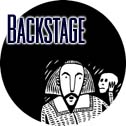
Comment
on this story
What:
Art
When:
Through Sept. 14
Where:
Clarence Brown Theatre
Cost:
Call 974-5161 for show dates and ticket info.
|
|

Art�holds a mirror up to nature of the human sort
by Paige M. Travis
On one level Art, the first play in Clarence Brown Theatre's 2002-03 season, is about three friends and their intellectual and emotional dynamic. Marc, Yvan, and Serge are not your everyday Joes; they're the creation of French playwright Yasmina Reza, which makes them different from most people you know. They discuss philosophy and art. They psychoanalyze each other. But Art is also about human nature on a bigger scale. The characters represent the inner voices that speak to us all. They are the parts of each of us that accept, or judge, or just ride the fence.
"Tolerant is the worst thing you can be when it comes to relationships," says Marc (John Forrest Ferguson) in the first minutes of the play. More than just the cynic of the trio, Marc takes cynicism to the extreme limits of bitterness and contempt. He doesn't want to be happy, and he doesn't want anyone else to be happy either. He's also, according to Serge, smug, insensitive, and condescending.
Serge (Guiesseppe Jones) is friendly and open. His growing taste for modern art has inspired him to hang out at art galleries and purchase a painting for 200,000 francs, approximately $50,000. The painting, considered one of the finest works of the revered painter Antrios, is white paint on a white canvas.
The painting turns out to be a screen on which Serge, Marc, and Yvan project their feelings for each other, and those feelings are reflected back with varying results. Serge wants his friends to like the painting and be glad for his acquisition. Marc can't stand the painting and refuses to understand why his friend would buy such a thing at such a cost. And Yvan (David Brian Alley) has his own problems to deal with and just wants everyone to get along, which aggravates both Serge and Marc.
The friends proceed to argue about the painting, which evolves into a contest to see which of each other's personality traits they hate the most. One pits another on the third to prove a point or merely as a tactic in the war of words. Since each character is a type, an angle on the situation, the actors have created three very distinct personalities. The power struggle is subtle, as is the deep river of feelings these long-time friends share. Ferguson, Jones, and Alley make it so easy to care about these men as they perform a kind of dance that transforms as the partners change configuration. They do and say things to each other cruel enough to make you cringe. As actors, their success is in transforming Reza's sharp and witty text into real guys worried about really important things.
Art is funny and fierce and surprising. As the play progresses, the characters reveal elements of themselves that intensify the emotions and the viewer's investment in the men. Reza has written a play that builds to a climax in action and character development. By the end of 90 minutes, you really know these men and have internalized their arguments. How does a person's taste in art reflect his character? And what does his opinion (educated or not) mean about his core values?
One of Serge's critiques of Marc is that because he does not participate in or appreciate modern culture, he is not a man of his time, a man representative of his era. But I disagree. As a man who belittles everything and believes in nothing, Marc is a perfect representative of his generation. Or, at least, mine. Marc could easily be a man in his late 20s living in Knoxville, working a mediocre job and watching himself get older with no prospects for a meaningful future—bitter, cynical, jealous, and loathing for a million reasons and not one of them very substantial. These characters and their discussion—which is both abstractly intellectual and intrinsically human at the same time—are very much a part of our time. Written in 1994, Art isn't really new, but it's still a progressive work of art, which explains why it's been performed in London since 1996 and is now on its 25th cast.
Art is so full of ideas—about the role of friends, the matter of aesthetics, the purpose of art—that they come whizzing by you at light speed, too fast to grasp them all. The dialogue is like listening to a great conversation at a party full of people from different backgrounds, philosophies, and religions. They toss their notions out on the table for you to consider, and your mind is boggled. You are intrigued and fascinated. You go home a little fuzzy-headed from all the stimulation. But when you think back on all the ideas and opinions you heard and shared, you think you might know yourself—and the people with whom you share this world—a little better for the experience.

September 12, 2002 * Vol. 12, No. 37
© 2002 Metro Pulse
|